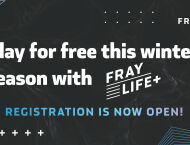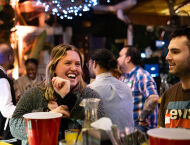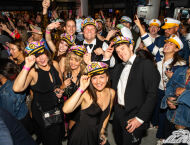Music
 Niccolo Seligmann // Photo: courtesy of Strathmore
Niccolo Seligmann // Photo: courtesy of Strathmore
Niccolo Seligmann Talks Strathmore’s AIR Program, Activism And More
February 25, 2020 @ 12:00am
Niccolo Seligmann is a man of many instruments. Over 20 and counting, in fact. The Johns Hopkins’ Peabody Institute alumnus specializes in early music, medieval music and noise music, just to name a few of his genres. While he is clearly a very accomplished 26-year-old, Seligmann needed more direction in his life. When his mentor suggested that he apply to the Strathmore Artists in Residence program (AIR), he jumped at the chance. Seligmann wanted to gain not only new perspectives on his music, but the tools to be a successful artist.
“At Peabody, I learned how to be a musician,” Seligmann says. “But I didn’t really get taught the business side of this life, and I feel like this residency has given me the resources to be a successful, business-minded musician instead of just a musician.”
Tomorrow, Seligmann will celebrate the release of his newest album, Kinship, with a concert held at The Mansion. Before his performance, we spoke to Seligmann about the AIR program, how he got into early music and what his music means.
On Tap: What do you hope to gain from your time as a resident?
Niccolo Seligmann: I felt like, for the past five years, I’ve almost been stymied. I didn’t know what to do next in my career. At Strathmore, I am being given resources for what to do in any given situation. I don’t need help being unique and standing out, I think I’ve got that part down. What I really needed was help figuring out how to treat my music like a business. That information is invaluable.
OT: As an artist who specializes in some unique and niche genres, how have you and the other residents learned from one another?
NS: I love learning from the other residents. I feel like I have learned so much from them, especially on how to run my music as a business. I have been able to collaborate with some of the other residents as well, I’m playing with one of them during their performance in the coming weeks.
OT: You clearly play a lot of different instruments, but what got you started in the music world? How did that preliminary introduction into music shape your eventual career?
NS: Well, my mother was in the military. Before my birth, my parents were stationed in Germany. My father already played the violin but was introduced to early music while in Germany and loved it. Fast forward to when I was five years old: my parents took me to a concert where someone happened to be playing the coolest instrument I had ever seen, the viol de gamba.
I was immediately drawn to it, and turned to my parents and said “Mommy I want to play THAT!” Of course, my mom said, “yeah, sure you do,” and got me a cello instead. Funnily enough, the woman who was my cello instructor actually played the viol de gamba. She had her own instructor at Peabody, and began teaching me to play as well. Eventually, I outgrew what my teacher could offer and moved on to lessons with her instructor at Peabody.
OT: If you had to choose, which instrument is currently your favorite to play, and why?
NS: This is always such an interesting question to get. My favorite instrument is always my newest instrument. I love being at the beginning again, it’s so thrilling to learn how to bring out the best in a new instrument. Any instrument with strings and a neck can be thought of as an x-y grid, which you can apply to any instrument because you are familiar with the grid. The challenge is to find the way to get the best sound from the instrument. Take the lirone, [it’s] about cello-sized, but it has 13 strings and an almost flat bridge. You can play as few as two strings to as many as nine strings at once. It is an instrument defined by its limitations.”
OT: One of the many genres you specialize in is “noise music.” How do you transform “unpleasant noise” into music? What is the difference, to you, between noise with meaning and without meaning?
NS: Noise with meaning versus noise without meaning…the best way I have to explain this is that listening to noise music and harsh music is a similar experience to eating a bag of unsalted potato chips. They’re still potato chips, but harsh and monotonous on purpose. Any sort of recognizable sound you can identify is like getting a single grain of salt on the unsalted potato chip, it is the most delicious and satisfying thing in the world.
Noise is a part of a larger palate. Noise is more powerful in the context of beauty; if you mix the ugliness and harshness with beauty you find the power in ugliness. Classical measure of what is considered good versus bad isn’t a good way to measure things. Is there even such a thing as bad music? It’s really just one way versus another.
OT: Your upcoming album, Kinship, addresses issues such as capitalism, indigenous sovereignty, and our relationships with nature. How do you relay these themes to listeners in instrumental music?
NS: These ideas are not just out of nowhere; they are based on real personal relationships I have formed with indigenous people in Northern Florida thanks to my husband’s work there. People should definitely be skeptical of white people making indigenous music or speaking out about indigenous rights. I am still learning about how to use my privilege to help indigenous people.
The whole album was recorded in a single day, on a first-take improvisation, almost entirely unedited. I was angered and upset and needed to record my emotions. It wasn’t really about any one issue, but how all of these issues – toxic masculinity, indigenous sovereignty, the imbalance of capitalism – intertwine and affect us emotionally. There was a general feeling of fire in the moment, and it became obvious what the album was about after everything was recorded.
OT: How do you use your music to further social causes that you are passionate about?
NS: There is one cause: all of them. All of the causes are intertwined and stem from a failure to recognize kin. Kinship extends beyond family and humans; we need to recognize the larger forms of kinship. We as humans are still related to animals and plants. Being cognizant isn’t necessarily activism.
Many people don’t speak about these issues though, which is step one. Incorporating acknowledgments is going to be a part of the tour for Kinship. I will acknowledge that where we are was this tribe’s land before us, and before them it was someone else’s, and that’s where it gets tough. You can’t simplify the narrative, there is so much more to it. I am using my privilege to address the status of these issues, but I’m still learning. I look forward to conversations with others on these topics so that I may learn from them and do better in the future.
OT: You still sell CDs of your music; do you think there will be a CD renaissance like the vinyl renaissance?
NS: I have actually sold more CDs than any of the other [Strathmore] residents. The early music community is mostly made up of 50 to 80-year old’s who still use CDs instead of Bluetooth, so that helps with sales. However, Kinship isn’t early music and people are still buying it on CD. Harsh music is sold almost exclusively on tape, which seems nonsensical because cars don’t have the capacity to play tape anymore.
Less wealthy people who can’t afford new cars, however, are listening to punk in their car. The renaissance for CDs will go with car buying; people will be buying used cars from before 2010 and don’t have reliable Bluetooth or an AUX cord but have a CD player.
I also like the amount of time you have on a CD. What if you have something bigger to say than a single allows? A CD kind of forces people to listen to the whole album, as it was intended. Kinship was almost just one single, long piece instead of multiple tracks working together. In the end, it is still one long 42-minute piece of work. Having it on a CD encourages people to listen to it that way.
OT: When you’re not creating music, what do you listen to?
NS: It really depends on my mood. I tend to fall towards acoustic music. I have really been into Bulgarian folk music and Ethiopian classical. I am a big fan of medieval music. The Inuit throat singer Tanya Tagaq is really taking it to a new level. I find a lot of my new music to listen to by buying old CDs in bulk. I can get, like, 80 CDs for $50. If one of them doesn’t work, I haven’t wasted that much money. It’s a great way to find musicians you haven’t heard of.
OT: What’s next for you in 2020?
NS: I’ll be going on my Kinship tour, and then going to Portland to perform with a friend. I’m also putting together a program with a medieval ensemble. And, of course, I’m playing this Wednesday for my album release concert at Strathmore.
Seligmann plays The Mansion February 26 at 7:30 p.m. Tickets are $19. For tickets, click here. To check out more of his work, click here.
The Music Center At Strathmore: 5301 Tuckerman Ln. Bethesda, MD; 301-581-5100; www.strathmore.org







